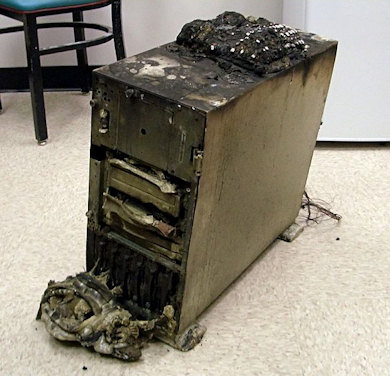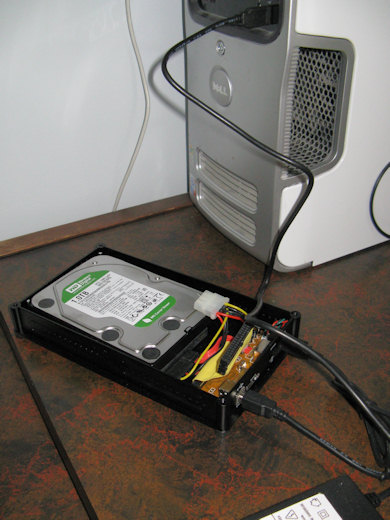Do you have precious pictures, music, and documents on your computer? I can’t tell you how many times people have asked me to help recover data from their failed hard drive. Consider this advice your data insurance plan. I think most of us would prefer to have a $300 fail-proof plan (on 1 terabyte of data, or as little as $50 if you only have a few gigabytes) compared to the $1000 to $3000 data recovery cost – with no guarantee – if your drive dies. I will use my own experience in buying a new drive, enclosure, and testing software to illuminate some of the things you should consider when it comes to backing up your data. I’m almost as wet behind the ears as the next guy when it comes to home-user backup strategies, so don’t take this as gospel advice. Please chime in with your own backup strategy.

Initial considerations
Data backup applies to the “nothing worth doing is ever easy” philosophy. Creating a strategy isn’t an easy 3-step process which is why there is so much technical information in this tutorial. Hang on tight and digest what you can.
Here are the major features I was looking for in my plan. They should give you a few things to think about before getting the supplies for your own backup plan. Basically, just ask yourself what is worth saving and how you would go about restoring the data if you lost it.
- Inexpensive. I always like to use free software if it’s available. Hard drives and thumb drives are less expensive and more flexible than tape drives (usually only used in corporate environments) or CD/DVD rewritable drives.
- Timeless (unhindered by future software and hardware changes). For example, I don’t want the data I back up today to be inaccessible next year because Windows 7 doesn’t support the recovery software needed to restore that data.
- Flexible. Along with being timeless, I want a strategy that works on as many platforms as possible: online, offline, Windows, Mac, Linux, and of course the fifth dimension (kidding).
- Fast. Quick and simple backup and restoration. Hard drives and flash drives are more universally accessible and faster than online storage or tape drives.
- Scalable. I want a strategy that works on small data sets as well as large ones. In other words, I don’t want to have to learn how to use 3 different programs in order to back up 300 MB of data, 5 GB of data, and 600 GB of data.
Supplies & strategy
Until this year, I had a piecemeal backup strategy that included anything from CD-backup to Yahoo! Briefcase. There was no telling what I had backed up or where it was. I copied data to old hard drives I might have laying around, but rarely more than once every year or two.
I won’t get into the “Whys” in the rest of this entry as it would require a book to explain the pros and cons to each of the methods I’ve chosen. Here are a few good articles if you want more background:
- PSA: backups
- Windows Live Sync vs. Live Mesh vs. SkyDrive: Which is Right for You?
- Wikipedia: List of online backup services, List of backup software
There are products available to make it easy to back up your data monthly, daily, and even every 5 minutes. Here are the basic steps I’ve taken in my backup journey.
- Separate data and system files. Disk partitioning is a foundational concept in data management. Basically, you want to try to keep your pictures, music, documents, and other non-program files on a different drive letter than your operating system files and applications. TreeSize, Duplicate Cleaner, and WinMerge are free apps (Beyond Compare has a 30 day free trial) I used to analyze, separate, and organize my data before even deciding how I wanted to back things up.
- How much & how often. This step requires the most thought. My main Windows XP partition (C drive) on my desktop computer typically uses 40 to 50 GB of space. I keep all my documents, music, videos, and pictures on a second internal 500 GB hard disk (G drive) of which I’m currently using about 300 GB. For most of this data, I don’t need to back it up more than once a month. Some documents that I access frequently, though, might be worth backing up daily or at least weekly. I want to have one off-site copy of the data that I update once or twice a year as well as a second copy that I update at least once a month. My strategy employs 3 hard drives plus online storage for more frequent backups.
- Buy your backup drives. Most users probably don’t need anything more than a couple of USB flash drives (that’s where I came up with my $50 estimate) to back up their data. I probably should have shelled out another $85 for a second 1 TB (1000 GB) drive, but I’m using my 250 GB drive as the second backup (critical files only). I also bought a handy IDE/SATA/e-SATA enclosure (pictured below) to make it easy to access any backup hard drive I might have.

Sabrent ECS-STU35K enclosure & WD10EARS 1 TB drive. - Choose an interface. Sorry if I lose you here, but I’m trying to keep it as brief as possible. I evaluated half a dozen products before landing on Cobian Backup (I’ve finally gotten out of the habit of thinking and typing “Cobain”). Unfortunately, most of the products that I found only work in Windows. My favorite tech forum, dslreports.com, has a handy Backup & Imaging Programs – 2009 Member Choice Poll if you want to see more options. Acronis True Image is an industry standard product, but I wouldn’t use it enough to bother paying $50 for it.
One technique that I haven’t decided on yet is imaging. This basically clones your operating system so you can later restore it or copy it using one file (another reason to keep your system files and data separate). Acronis does both basic file backup and imaging – I couldn’t find a free tool that would do both, but it looks like DriveImage XML is a lightweight tool (1.8 MB setup file) that will do the job. FYI, many manufacturers, like Dell and HP, include a recovery partition on their computers. This is basically an image of the original system configuration.
I have set up several backup jobs with Cobian. One performs a full backup of the C and G drives to my new terabyte drive (the T drive). Another job runs weekly incremental (only new and changed files) backups to the T drive. Cobian supports the VSS feature introduced in Windows XP, so I was able to copy my C drive files even though many of them were in use. I haven’t had a chance to run an incremental job yet, but the full backup took 9 hours overnight (6 for 283 GB of data and 3 for 37 GB of running system files). Version 10 of Cobian just came out of beta yesterday, and it supports Windows 7; setup file is less than 15 MB. The free version of SyncBack is a similar product that will also sync files between folders, but it isn’t as feature-rich as Cobian.
I am also using SpiderOak online sync and backup for the few folders I want backed up at least once a week or more. It backs up files online and also syncs them with my laptop (SpiderOak runs on Linux & Mac, too, so it’s a great all-platform tool). Live Mesh is a nice non-Linux tool that works similarly.
- Prepare for recovery. This is like packing up your first aid kit and deciding where to put it. Put all of your major software discs together (like Office, Windows, Photoshop, etc.) and make sure you have the product keys for them (use Keyfinder if you can’t find your original packaging). I’m going to give my 250 GB yearly-backup drive to a friend to hold and I’ll keep my 1 TB drive in the enclosure and run Cobian monthly. I noticed that my new Western Digital drive has a 3 year warranty as well as an upgrade discount if I want to buy another drive at a discount within my warranty period. They also provide recovery referral discounts. Yes, even if your drive stops working, there are companies that can probably recover most, if not all, of your data. However, most of these services cost at least $1000.
So there you have it. Backing up your data takes a lot of planning and initial setup, but you’ll be quite glad you did it when one of your hard drives decides to die. If you set up everything properly in the beginning, your subsequent backups should be automated, so it doesn’t take much effort to continue saving your data.
Random video of the week: Joanna Newsom, Sprout and the Bean. She’s playing Nashville on Sunday night, $20 Mercy Lounge.
Comments
4 responses to “Your hard drive will die… Back it up”
we use amazon web service…i back up photos and documents to the “cloud” using jungledisk. It only costs us about $6/month and it happens in the background. I have web access as well as a virtual machine that sits on my desktop so that I can drag items there if I want them backed up immediately (which I do every month for the quicken file). It would be more expensive if I backed up our music, but I figure we have CD backups of that stuff–it's just a lot of work to get it back. Also, I'm not so into the music that I've made a lot of playlists and stuff that I want to preserve, so I'm not worried about that too much.
Our service is also nice because our whole family, from their separate computers, can back up their documents and important stuff to their own folder on our virtual machine in the cloud. I love it!
Thanks for chiming in with your setup! How much data can you store? What do
you mean by “virtual machine”? Is it a cloud operating system, or just an
online drive to store data? Got links to the service(s)?
I don't like to rely on web storage mainly because I have so many music
files that I download frequently. Would probably get too slow to back it up
online. That's why I use SpiderOak for my smaller, essential files – 2 GB of
free space and no file size limits. Not as good a deal as Amazon/Jungle
Disk, possibly, as it's $10/mo for each 100 GB you want to add on.
I didn't include this “why” in the post, but I don't like the idea of
storing my data on someone else's server. This is why I stick mainly with
physical hard drives for backup. Plus, if you have Internet issues, you
don't have to worry about accessing your data.
that's some good info. i have been considering subscribing to carbonite and am glad to know about spideroak since they offer different levels of service and allow more than one computer to use their service.
i've been doing my backups manually since i had a 500gb external network drive that died on me and i had to pay to have it recovered. fortunately, i had all the stuff i wanted in one folder (with many sub folders) and only had to pay $25 to recover one folder even though it was 400gb of data.
right, i didn't mean “virtual machine” but “virtual hard-disk”, sorry! Here is the link for jungledisk…
http://www.jungledisk.com/personal/desktop/pric…
that link is to what we decided to use. there are other options on their site.
cheers!